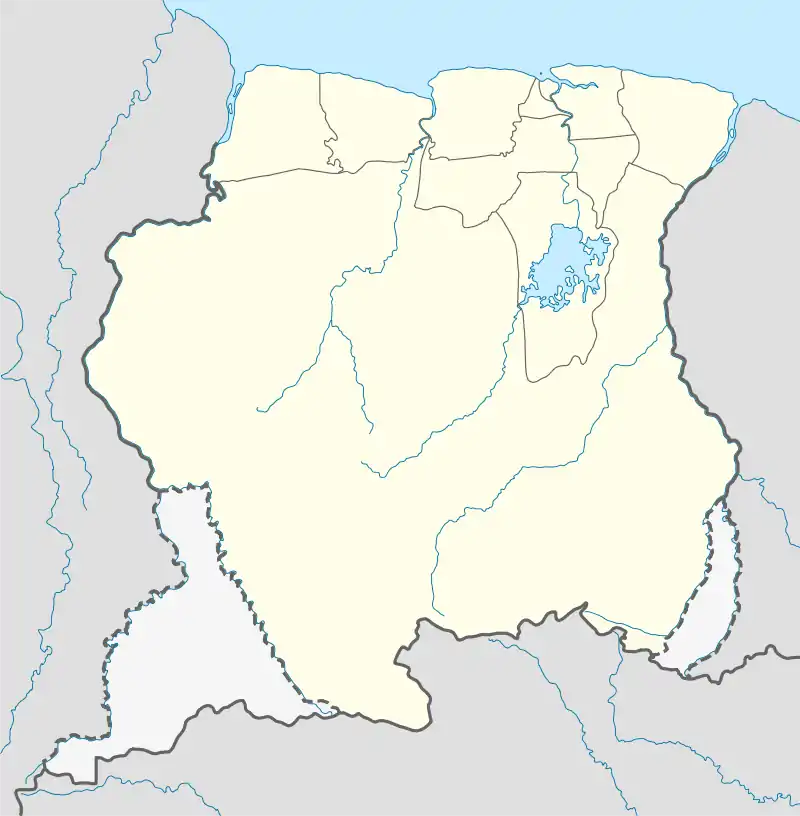2009 Albina, Suriname riots
The 2009 Albina, Suriname riots took place on December 24–25, 2009,[2] when local maroon inhabitants attacked Brazilian, Chinese, Colombian and Peruvian gold miners after a man was stabbed to death by a Brazilian.[3]
2009 Albina, Suriname riots Location of Albina within Suriname | |
|---|---|
| Location | Albina, |
| Date | December 24–25, 2009 (UTC-3) |
| Deaths | 1[1] |
| Injured | At least 24 |
One death was confirmed by the local police authorities, but Roman Catholic Brazilian priest José Vergílio, which was aiding the victims, said that at least seven people died.[2][4] According to minister Chan Santokhi of Justice and Police this information was not confirmed. He stated that the stabbed person was the only one killed.[5]
Vehicles and houses were burned and stores owned by Chinese were plundered.[6] According to the Surinamese government, 20 women were raped, one of which was pregnant and lost her baby in the trauma.[2][7]
At least 24 people were injured during the riots.[8] The injured were transported to a military hospital, while the Brazilians living in Albina were transferred to Paramaribo.[8] Brazilians and Chinese living in the region have been evacuated.[4] According to eyewitnesses, 17 people are missing.[2]
The Brazilian government sent a diplomatic mission on December 27, 2009, to attend the Brazilian victims.[9] Five Brazilians returned to Brazil on December 27 on an airplane of the Brazilian Air Force.[10] On December 28, an airplane with capacity for 40 people was sent to the city with the purpose of rescuing more Brazilians.[10] The Surinamese government sent in troops to conduct searches and keep the peace, although violence is over by all accounts.[2] Suriname officials have come out saying they have the forces to protect all foreigners in the country and have already taken several people into custody for questioning.[2] 35 suspects were arrested on December 28, according to the city's chief of police, Krishna Mathoera-Hussainali.[10]
Background
Albina is primarily a base for nomadic gold prospectors.[2] The town is made up of people from Suriname, neighboring French Guiana, the People's Republic of China and Brazil.[2]
There are between 15,000 and 18,000 Brazilian nomad gold diggers in Suriname, or about 4% of the total population of the country, most of them living illegally.[2] They are some of the poorest people in Brazil, mostly from the Northeast Region.[2]
Tensions in gold prospecting villages like Albina are not sporadic, but violence is quite uncommon.[2] Gold diggers often come in conflict with indigenous people in their search to find and extract gold from remote areas.[2]
References
- Radio 10, Persbriefing, Chan Santokhi, minister of Justice and Polics, 25 December 2009
- Elizondo, Gabriel (December 27, 2009). "Christmas violence in Suriname". Al Jazeera. Archived from the original on December 31, 2009. Retrieved December 27, 2009.
- "Conflito no Suriname levou a pelo menos 7 mortes, diz missionário" (in Portuguese). G1 Globo.com. December 26, 2009. Archived from the original on December 31, 2009. Retrieved December 27, 2009.
- "Priest: 7 migrants killed in Suriname violence". Washington Post. December 27, 2009. Retrieved December 27, 2009.
- Radio 10, Persbriefing, Chan Santokhi, minister van Justitie en Politie, 25 december 2009
- "Suriname reforça segurança após ataque a brasileiros" (in Portuguese). Estadão. December 28, 2009. Retrieved December 28, 2009.
- "Surinam sends troops to Albina". Radio Netherlands Worldwide. December 26, 2009. Archived from the original on June 7, 2011. Retrieved December 27, 2009.
- "Missão da FAB deve ir ao Suriname para prestar auxílio a brasileiros" (in Portuguese). G1 Globo.com. December 26, 2009. Archived from the original on December 30, 2009. Retrieved December 27, 2009.
- "Brasil envia missão diplomática ao Suriname para atender brasileiros atacados" (in Portuguese). December 27, 2009. Retrieved December 27, 2009.
- "Suriname: detidos 35 suspeitos de agredir brasileiros" (in Portuguese). iG. December 28, 2009. Archived from the original on February 29, 2012. Retrieved December 28, 2009.